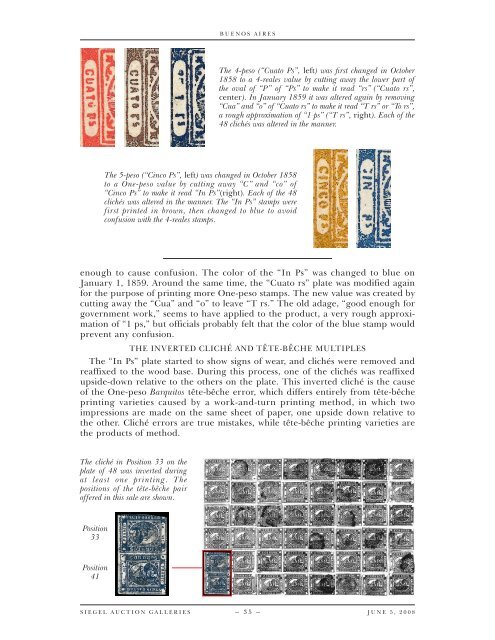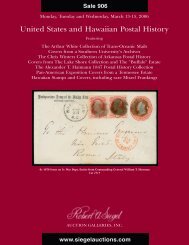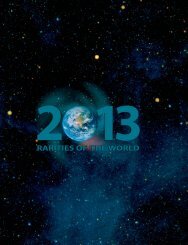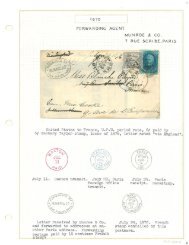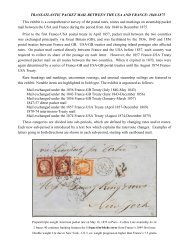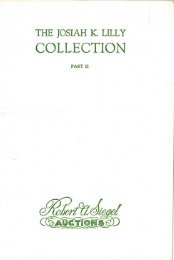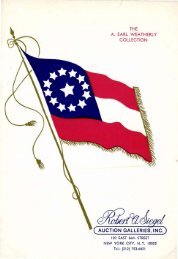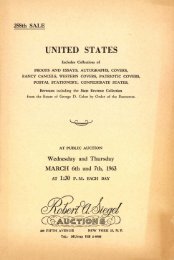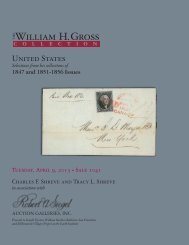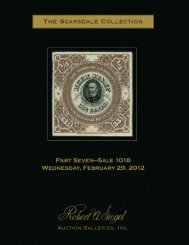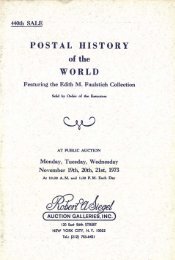The “In Peso” Tęte-Bęche Pair - Siegel Auction Galleries
The “In Peso” Tęte-Bęche Pair - Siegel Auction Galleries
The “In Peso” Tęte-Bęche Pair - Siegel Auction Galleries
Create successful ePaper yourself
Turn your PDF publications into a flip-book with our unique Google optimized e-Paper software.
BUENOS AIRES<br />
<strong>The</strong> 5-peso (“Cinco Ps”, left) was changed in October 1858<br />
to a One-peso value by cutting away “C” and “co” of<br />
“Cinco Ps” to make it read <strong>“In</strong> Ps”(right). Each of the 48<br />
clichés was altered in the manner. <strong>The</strong> <strong>“In</strong> Ps” stamps were<br />
first printed in brown, then changed to blue to avoid<br />
confusion with the 4-reales stamps.<br />
<strong>The</strong> 4-peso (“Cuato Ps”, left) was first changed in October<br />
1858 to a 4-reales value by cutting away the lower part of<br />
the oval of “P” of “Ps” to make it read “rs” (“Cuato rs”,<br />
center). In January 1859 it was altered again by removing<br />
“Cua” and “o” of “Cuato rs” to make it read “T rs” or “To rs”,<br />
a rough approximation of “1 ps” (“T rs”, right). Each of the<br />
48 clichés was altered in the manner.<br />
enough to cause confusion. <strong>The</strong> color of the <strong>“In</strong> Ps” was changed to blue on<br />
January 1, 1859. Around the same time, the “Cuato rs” plate was modified again<br />
for the purpose of printing more One-peso stamps. <strong>The</strong> new value was created by<br />
cutting away the “Cua” and “o” to leave “T rs.” <strong>The</strong> old adage, “good enough for<br />
government work,” seems to have applied to the product, a very rough approximation<br />
of “1 ps,” but officials probably felt that the color of the blue stamp would<br />
prevent any confusion.<br />
THE INVERTED CLICHÉ AND TÊTE-BÊCHE MULTIPLES<br />
<strong>The</strong> <strong>“In</strong> Ps” plate started to show signs of wear, and clichés were removed and<br />
reaffixed to the wood base. During this process, one of the clichés was reaffixed<br />
upside-down relative to the others on the plate. This inverted cliché is the cause<br />
of the One-peso Barquitos tête-bêche error, which differs entirely from tête-bêche<br />
printing varieties caused by a work-and-turn printing method, in which two<br />
impressions are made on the same sheet of paper, one upside down relative to<br />
the other. Cliché errors are true mistakes, while tête-bêche printing varieties are<br />
the products of method.<br />
<strong>The</strong> cliché in Position 33 on the<br />
plate of 48 was inverted during<br />
at least one printing. <strong>The</strong><br />
positions of the tête-bêche pair<br />
offered in this sale are shown.<br />
Position<br />
33<br />
Position<br />
41<br />
SIEGEL AUCTION GALLERIES – 35 – JUNE 5, 2008


